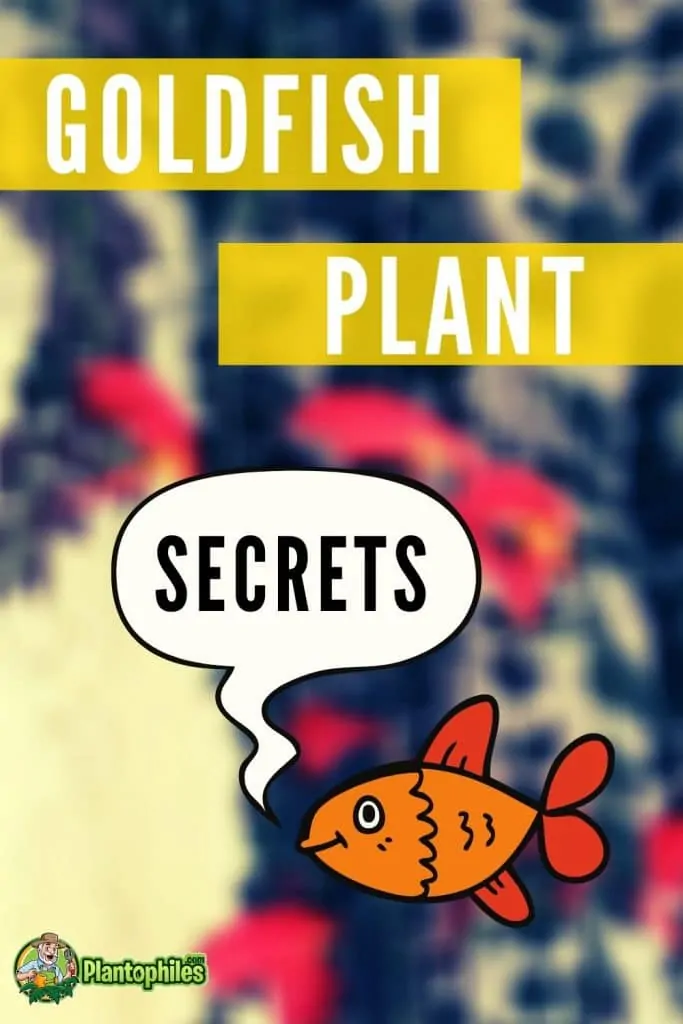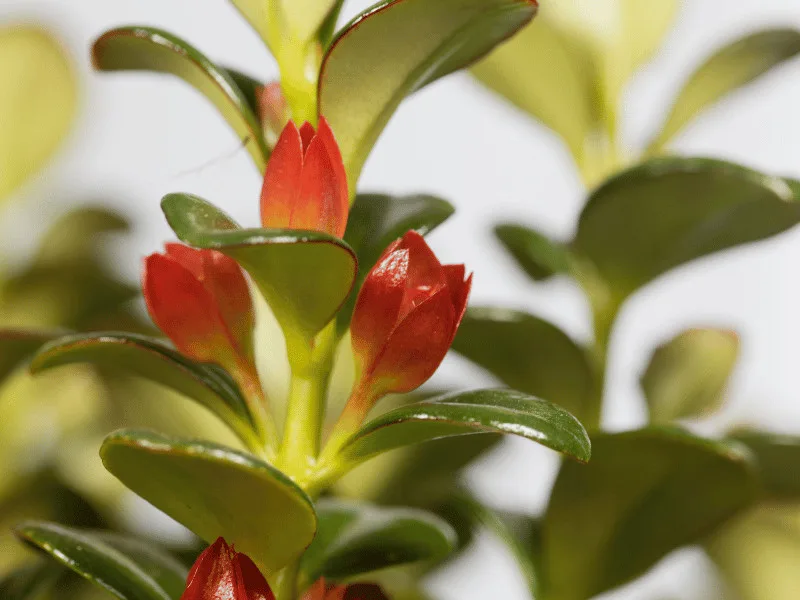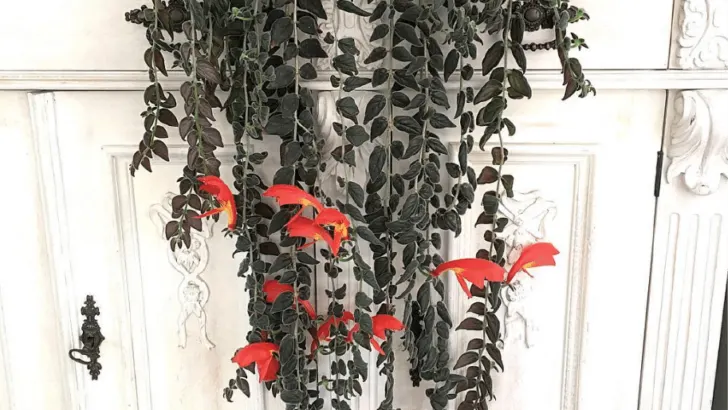The Goldfish Plant (botanical name Columnea gloriosa) is one of the less known but all, the more beautiful houseplants that are easy to care for. The fish-shaped flowers and their color have earned the nickname ‘goldfish plant’ in the English-speaking world.
Botanically, the genus Columnea belongs to the family of Gesneriaceae. Typical for all columneas are the long, hanging shoots (up to 95 cm). For exactly this reason, Columnea gloriosa is best suited as a hanging baskets plant.
Table of Contents
Goldfish Plant Care
To best care for a Goldfish plant, use a regular potting soil mix. Provide bright indirect light. Water once a week. The ideal temperature is 64-75 degrees Fahrenheit. Water once a week once the soil is almost dry. Fertilize every two weeks in spring and summer.

Goldfish Plant Plant Care
Soil
The Goldfish Plant is anything but delicate when it comes to soil. Choosing the right soil should be relatively easy even if you don’t have a green thumb.
A regular potting soil mix is sufficient for the goldfish plant, but it can also be kept in hydroponics (a method of growing plants without soil). Another good choice is African violet potting soil (containing peat moss & perlite).
Light
Columneas thrive best in light to semi-shady locations. The plant cannot tolerate direct sunlight, as this will cause its leaves to burn. If you want to use artificial lights, that also works well with Goldfish plants.
Placing your plant around 1 meter from an east-facing window generally produces great results. Keep in mind that light conditions change throughout the day and the season. Therefore, it might take you some time to find the perfect spot for your Goldfish plant.
Watering
Water once a week.
Spring to summer: Water your Goldfish plant with lukewarm water (tepid water). Watering your plant with cold water could result in leaves with unsightly brown spots. The soil should be kept slightly moist at all times.
In winter, however, you need to decrease watering. Make sure that the soil almost becomes dry before “rewatering.”
Temperature
Provide average room temperatures between 64-75 degrees Fahrenheit (18 to 24 degrees Celsius) all year round.

Humidity
The ideal humidity is 40-50%. Moderate humidity is best for this plant.
Fertilizer
Feeding your Goldfish plant with a high-phosphorous fertilizer is a good idea.
The dosage of fertilizer should always be slightly below the dosage recommended by the manufacturer, as this avoids overfertilization, which is also unfavorable to Columnea gloriosa.
Beginning in spring and up to summer, feed your plant every two weeks. In colder months (winter), feeding your Goldfish plant once a month will be sufficient.
Propagation
Goldfish plants can be propagated by rooting stem tip cuttings. The best time for propagation is spring or summer. It is always a good idea to stick more cuttings than you need because there is always a risk that some of them fail.
You might also want to use a rooting hormone (rooting) powder when propagating your leafy friend, as this will drastically improve your odds of success.
Growth
Columnea Gloriosa is a very slow grower. However, its stems can grow up to 95 cm. Nevertheless, you will want to prune your Goldfish plant regularly for a bushy look.
Potting
Repot once every two years. As for the choice of container, aim for a medium-sized container.
How to Propagate a Goldfish plant
To ensure that your Goldfish plant becomes your lifelong friend, let’s look at the best methods to propagate this gorgeous houseplant.
As far as propagating houseplants go, six different techniques are commonly used:
- air layering
- division
- rooting stem cuttings
- rooting leaf cuttings
- simple layering
- growing new plants from seeds
However, it needs to be mentioned that not every method applies to every houseplant. While some methods may work great with your houseplant, others might not.
So what is the best method to propagate your Columnea Gloriosa?
The best method to propagate your goldfish plant is by rooting stem cuttings or, more precisely, rooting stem tip cuttings.
To propagate a Goldfish plant, follow these steps:
- Search your plant for healthy, non-flowering stems.
- Use a sharp, sterile knife to proceed with the cuttings.
- Cleanly cut the stems that you would like to propagate. Leave some of the stems (about 5 to 7.5 cm) while doing so; we only need the stem tip! (about 7,5 cm long) to propagate
- Pull off the bottom leaves of the stem cuttings.
- Dip the stem cuttings in rooting powder (rooting hormone). If you don’t have that, you can easily find it in garden centers or on the internet.
- Root the stem tip cuttings (remember: should be about 7.5 cm long) in a container of your choice. As for the soil, we recommend a light mix of peat & perlite.
- Lightly water your newly propagated plants.
Note: Newly rooted cuttings will take at least a year to bloom. The best time for propagating your Goldfish plant is in spring/summer.
Watering your Goldfish plant
Water about once every 7 days as a general rule of thumb.
As with any other houseplant, it doesn’t make sense to water your Goldfish plant according to a fixed timetable. The important thing to remember here is that your Goldfish plant likes it pretty moist.
So, what you should do is you should check if the top layers 1-2 inches (meaning the top 2.5-5 cm) of the soil are dry or not.
You can put your finger inside the compost to verify.
If you conclude that the compost’s top is dry, you should give your leafy friend some water.
Make sure to use either distilled water or rainwater.
Note: Your goal should always be to make (and then keep) the compost of your Goldfish plant (slightly) moist but not wet.
Both underwatering and overwatering your Goldfish plant can result in serious damage to your plant.
A lack of water and an excess of water can lead to wilting. Proper watering of your Goldfish plant (basically any houseplant) is essential, and incorrect watering might be the number 1 reason why houseplants die.
Goldfish Plant Pest and Diseases
Problem: Brown leaf tips
Cause: If your Goldfish plant features brown leaf tips, chances are that you have an excess of calcium in the soil.
Remedy: Make sure to use a fertilizer that is low in calcium. When watering, rainwater or distilled water should be your weapon of choice. Tap water is not recommended. If you do use tap water, make sure that it is lukewarm.
Problem: Faint webbing on leaves
Cause: Most likely, you are dealing with Spider mites. An infestation with spider mites will likely occur in late fall/winter. Spider mites are super tiny. They are tough to spot. You need a magnifying glass actually to see them.
Remedy: One way to go about this is to use a water spray to blast off the pests gently. Spider mites generally hang on the undersides of the leaves, so you need to spray that part of the leaf specifically!
If the infestation has already got bad, you might need to prune off badly infested branches.
And if all of that is not helping, you might even need to discard your Goldfish plant. Spider mites are tiny little devils 🙁
Problem: White fuzzy stuff on leaves and stems
Cause: If you discover white cottony deposits on your plant, you are likely dealing with mealybugs.
Solution: The first thing you should do when discovering that mealybugs infest your houseplant is always to isolate your plant. After that, you should try to wipe off the mealybugs with the help of a cotton bud soaked in insecticide. However, it is not easy to get rid of mealybugs. And in some cases, you might need to discard heavily-infested plants.
Side note: Please remember that the best way to avoid pests on your houseplants is to ensure your plant stays healthy. Pests are far more likely to attack plants in unhealthy conditions.
Toxicity
The Goldfish plant is non-toxic to cats and dogs as well as humans. Houseplants, if you have pets, can be an issue as animals chew on them. Make sure they are not poisonous. So Columnea gloriosa are a great chouce.
Where to buy a Goldfish plant?
There are several places on the internet to get your goldfish plant. These plants are not cheap, though. Be ready to spend about 20 to 30 bucks to get your hands on one of these lovely plants.
Here are some good places to purchase a goldfish plant:
Columnea gloriosa: Who to follow on Instagram?
Instagram is still the right place to find stunning houseplants images and get inspiration and ideas for future purchases so you can expand your Urban Jungle accordingly.
So, if you are on the lookout for amazing Columnea Gloriosa pics, follow these beautiful people:
- @alivia_houseplants (all credit for the featured image of this post goes to Alivia! Thanks so much again!)
- @plantingplanties
Frequently Asked Questions
Is the Goldfish plant toxic to cats?
The goldfish plant is non-toxic to cats.
Is the Goldfish plant toxic to dogs?
Columnea Gloriosa is non-toxic to dogs.
What is the scientific name of the Goldfish plant?
The scientific name of the Goldfish plant is Columnea Gloriosa. However, other Columnea species are also commonly referred to as (Flying) Goldfish plants. Also, plants from the Genus Nematanthus are equally referred to as Goldfish plants.
Will Columnea Gloriosa thrive in direct sunlight?
Direct sunlight is not recommended because it causes the leaves to burn.
Can the Goldfish plant also be grown using artificial growth lights?
You can grow these plants using artificial lighting.
Is the Goldfish Plant suitable as a houseplant for the bathroom?
You can keep it in the bathroom, as Goldfish plants enjoy locations with high humidity. However, some houseplants are even better suited for the bathroom. You can find these in our article: The 12 best houseplants for your bathroom.
How long does it take for goldfish plant cuttings to bloom?
Newly rooted Goldfish plant cuttings must grow for at least 12 months before blooming.
Can I keep my Goldfish plant outdoors in summer?
It is advised to keep Columnea Gloriosa indoors in summer, as too much light (especially direct sunlight) and also high temperatures can potentially harm your plant (e. g., brown leaves). Also, low night temperatures can harm your plant as they do not correspond to the natural environment of the Goldfish plant.
What are some common pests found in Goldfish plants?
Goldfish plants are prone to Aphids (also called greenflies), scale bugs and spider mites.
What other exciting species and cultivars of the Goldfish plant (Columnea)?
Columnea gloriosa is already pretty spectacular. However, if you would like to go for something a little bit different, you could try a Columnea Hirta, a.k.a “Light Prince.” This species features white variegated foliage with stunning orange/red flowers. Moreover, these plants are known to be very hardy, and if you do not (yet) have a green thumb, the Columnea hirta “Light Prince” might be the ideal plant for you.
Any displaying tips for Goldfish plants?
Goldfish plants are perfect for hanging baskets. It’s the perfect way to show off its spectacular foliage and flowers. Moreover, Goldfish plants produce very long stems (up to 95 cm).
Are there other plants than the Columnea Gloriosa that are often referred to as the Goldfish plant?
Absolutely. Another houseplant that is often referred to as the Goldfish plant is Nematanthus wettsteinii.

Daniel has been a plant enthusiast for over 20 years. He owns hundreds of houseplants and prepares for the chili growing seasons yearly with great anticipation. His favorite plants are plant species in the Araceae family, such as Monstera, Philodendron, and Anthurium. He also loves gardening and is growing hot peppers, tomatoes, and many more vegetables.


